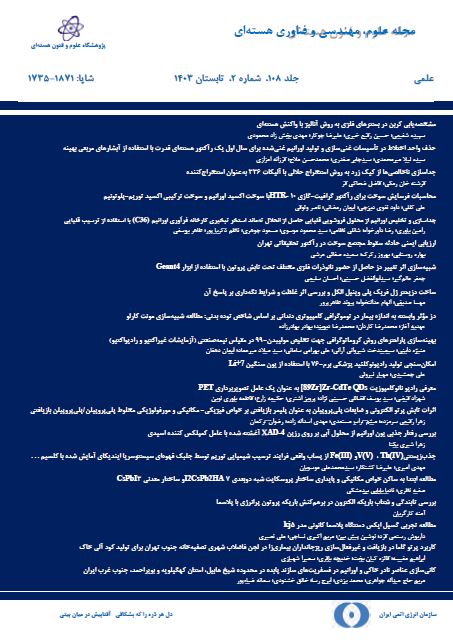نوع مقاله : مقاله پژوهشی
نویسندگان
پژوهشکده پلاسما و گداخت هستهای، پژوهشگاه علوم و فنون هستهای، سازمان انرژی اتمی ایران، صندوق پستی: 51113-14399، تهران- ایران
چکیده
یکی از دستگاههایی که به منظور محصورسازی پلاسما و انجام اندرکنشهای گداخت هستهای خصوصاً برای تولید نوترون مورد استفاده قرار میگیرد دستگاه محصورسازی الکترواستاتیکی اینرسی است. اعمال میدان الکتریکی قوی بین دو الکترود مشبک در این دستگاه، موجب یونیزاسیون و شتابگیری یونها به سمت ناحیه مرکزی آن میشود. انرژی یونها در این ناحیه بسته به اختلاف ولتاژ اعمالی بین دو الکترود چند ده کیلو الکترونولت است. لذا در صورت استفاده از گاز دوتریم موجب انجام واکنشهای گداخت هستهای و تولید نوترونهای سریع میگردد. داغ شدن بیش از اندازه الکترود مرکزی (کاتد) به علت برخورد یونهای پرانرژی یکی از معضلات عمده در این نوع دستگاهها است. این موضوع علاوه بر اینکه باعث عدم امکان کارکرد دستگاه در شرایط پایدار و در زمان طولانی میشود، توان اعمالی به دستگاه را محدود کرده است. در این کار پژوهشی، برای رفع این مشکل یک کاتد همراه با ورودی ولتاژ بالا با قابلیت خنک شونده در دستگاه IR-IECF ساخته و استفاده گردید. از آب دوبار-یونیزه به عنوان سیال خنککننده استفاده شد تا کاتد جدید با قابلیت آبگرد که متصل به منبع تغذیه ولتاژ بالا است بدون انتقال این ولتاژ به پمپ آب/ قادر باشد در توانهای بالاتر از 3 کیلو وات و بدون ذوب شدن به کارکرد خود ادامه دهد و در ضمن سیال خنککننده به دمای جوش نرسد. نتایج شبیهسازی با نتایج تجربی در این مورد توافق خوبی دارند.
کلیدواژهها
عنوان مقاله [English]
Design and construction of actively cooled cathode for inertial electrostatic confinement approach to extend the operational time
نویسندگان [English]
- A.R. Asle Zaeem
- M. Sedaghat Movahhed
- A. Bagheri
- M. Kabir
- M. Ghapanvary
- A. Kargarian
Plasma and Nuclear Fusion Research Institute, Nuclear Science and Technology Research Institute, AEOI, P.O.Box: 14399-51113, Tehran - Iran
چکیده [English]
Inertial electrostatic confinement fusion (IECF) devices are utilized for studying nuclear fusion reactions, particularly for fusion neutron production. A strong electric field between two transparent electrodes results in the formation and acceleration of ions toward the device's center. The energy level of these accelerated ions reaches tens of kilo-electron volts, sufficient to produce fast neutrons through nuclear fusion reactions when deuterium gas is used. Overheating due to collisions of high-energy ions with the cathode surface is a primary issue that limits the applied power and long-term stable operation of these devices. In this research, an actively cooled cathode was designed and constructed for the IR-IECF device. Deionized recirculating water was used as the coolant to reduce the cathode temperature. The cathode, connected to a high voltage power supply via a feedthrough, can prevent high voltage breakdown and melting at input powers exceeding three kilowatts. Both theoretical and experimental results show excellent agreement in heat removal during continuous operation.
کلیدواژهها [English]
- Inertial electrostatic confinement
- Deuterium fusion
- Cathode cooling
- Aslezaeem A.R, Ghafoorifard H, Sadighzadeh A, Movahhed M.S. Preliminary results of a miniature cylindrical inertial electrostatic confinement fusion device equipped with inductively coupled plasma generator. Journal of Instrumentation. 2019;14(07):T07007.
- Aslezaeem A.R, Ghafoorifard H, Sadighzadeh A. Discharge current enhancement in inertial electrostatic confinement fusion by impulse high magnetic field. Vacuum. 2019;166:286-291.
- Bhattacharjee D, Buzarbaruah N, Mohanty S.R. Neutron and x-ray emission from a cylindrical inertial electrostatic confinement fusion device and their applications. Journal of Applied Physics. 2021;130:053302.
- Bhattacharjee D, Mohanty S.R, Adhikari S. Effect of Positive Polarity in an Inertial Electrostatic Confinement Fusion Device: Electron Confinement, X-ray Production, and Radiography. Fusion Science and Technology. 2022.
- Takakura K, Nittoh K, Miyadera H, Yoshioka K, Karino Y, Hotta E, Hasegawa J. Neutron imaging with an inertial electrostatic confinement fusion neutron source. Applied Optics. 2022;61(5):1238-1240.
- Bakr M, Mukai K, Masuda K, Yagi J, Konishi S. Characterization of an ultra-compact neutron source based on an IEC fusion device and its prospective applications in radiography. Fusion Engineering and Design. 2021;167.
- Sharma S.K, Tewari S.V, Waghmare N, Raju S.J, Rao K.D, Sharma A. Compact inertial electrostatic confinement D-D fusion neutron generator. Annals of Nuclear Energy. 2021;159.
- Bowden-Reid R, Khachan J, Wulfkühler J.P, Tajmar M. Evidence for surface fusion in inertial electrostatic confinement devices. Physics of Plasmas. 2018;25(11).
- Masuda K, Nakagawa T, Kipritidis J, Kajiwara T, Yamagaki Y, Zen H, Yoshikawa K, Nagasaki K. Cathode grid current dependence of D(d, n) 3 He reaction rates in an inertial electrostatic confinement device driven by a ring-shaped magnetron ion source. Plasma Phys. Control. Fusion, 2010;52(9):95010.
- Park J, Krall N.A, Sieck P.E, Offermann D.T, Skillicorn M, Sanchez A, Davis K, Alderson E, Lapenta G. High-energy electron confinement in a magnetic cusp configuration. Phys. Rev. 2015;X5:021024.
- Seltzman A. Design of an actively cooled grid system to improve efficiency in inertial electrostatic confinement fusion reactors. Georgia Institute of Technology Department of Physics. 2008.
- Damideh V, Sadighzadeh A, Koohi A, Aslezaeem A, Heidarnia A, Abdollahi N, Abbasi Davani F, Damideh R. Experimental Study of the Iranian Inertial Electrostatic Confinement Fusion Device as a Continuous Neutron Generator. Journal of Fusion Energy. 2011.
- Asle Zaeem A.R, Sedaghat Movahhed M, Bagheri A, Kabir M, Rezaei M. Experiments on a new actively cooled cathode for the inertial electrostatic confinement fusion device to extend the operational time. Abstract on 1st International & 28th National Conference on Nuclear Science and Technology. 2022.
- García-Baonza R, Gallego E, Garcia F G.F. Combined application of Berthold LB6411 and WENDI-II rem-meters for neutron area monitoring in D-T neutron generators. Proceedings of the ISSSD. 2020.

